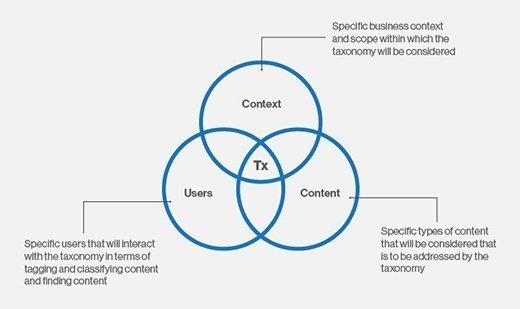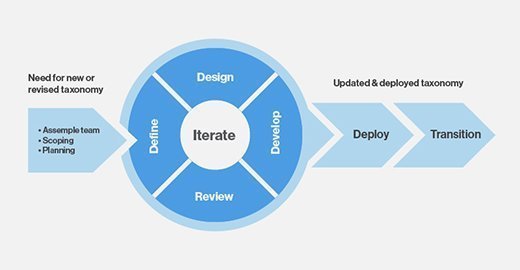
kentoh - Fotolia
8 steps to building a website taxonomy
Building a website taxonomy can help make website content better categorized and more easily searchable by users. Here are eight steps to building your own website taxonomy.
For those unfamiliar with the term, a taxonomy is a system of classification that enables systems like websites to be categorized according to topics and the like, and enables information retrieval.
If your organization sees the need for a website architecture that will be search-engine-friendly but you are unsure how to structure a taxonomy, this article outlines an eight-step taxonomy development process. These steps help crystallize the business purpose, the audience you're marketing to and the content types you need to categorize.
As in all development, it is necessary to understand the scope of the activity. A taxonomy development or taxonomy maintenance activity has three aspects (see Figure 1):

- Business context.What is the business purpose for the taxonomy? Is it for a specific initiative such as document management or for content management more broadly? If you intend to structure your data taxonomy for content management, is the content internally facing only, or does the content involve externally facing websites that customers and third parties use? The development of taxonomy structure may differ depending on the answer.
- User community.What is the target audience for the content? What are the user profiles, and what are their information usage needs? Do they use social media or internal social tools?
- What is the operational purpose of the content? Is it limited to a single team or departmental content or specific initiatives, or are there multiple types of content to be considered?
Once the scope has been defined, you can begin the taxonomy development process with these eight steps (see Figure 2):

1. Assemble the team
Typically, the core team consists of business representatives who work with the content, an information manager or someone assigned to the information management role, a taxonomy specialist, and a technical subject matter expert who understands the constraints and opportunities of the target technical environment into which the taxonomy will be implemented. Having a representative who understands categories and content governance, such as an information manager, is important.
2. Scope the problem
Which business areas are involved? Is it an enterprise problem or one affecting a specific business area? Where does the taxonomy need to exist? If core business entities such as clients and products are being modeled, where is the source of truth for those defined? For example, is it in corporate CRM and ERP systems?
3. Define the problem in detail
Capture examples of content that need to be categorized in the taxonomy with business knowledge, content audit and possibly search logs.
Determine the profiles of those users who will interact with the taxonomy -- findability in search engines is a key consideration -- and ask how certain user roles look for content. A paralegal may want to find contracts by legal entity, a design engineer may want to find product specifications by product type and a financial planner may want to find financial forecasts by year.
Ultimately, the desired results will create a matrix of types of content against metadata characteristics. If the taxonomy is to support a search-based application, the techniques are the same but additional dimensions should be considered, including the relationships among the content types that are likely to be stored in various content management sources.
4. Design the taxonomy
This involves either completing the matrix of types of content and mapping them with metadata or defining word tag characteristics. This ensures that metadata characteristics can be determined automatically by the system(s) as content is uploaded or that the user defines metadata characteristics from a predefined set of choices.
5. Develop and test the taxonomy
This involves soft testing using card-sorting techniques or hard testing by building out a working prototype and having focus groups interact with it. Businesses should try the latter. If your organization hasn't implemented a data taxonomy, the concepts can be too abstract to visualize how users will interface with it, so seeing is believing.
6. Review your findings
Revisit the definition, design and development stages, and work through potential changes based on testing. Building a taxonomy requires an agile approach with a minimum of three iterations. And observe the 80/20 rule: A taxonomy can't be perfect. Whatever you come up with is part of a journey.
7. Deploy the solution
Once the final iteration is done, complete the final development of the taxonomy and deploy it in target environments.
8. Transition
Implement governance and change management to support the effectiveness of the taxonomy, including its adoption.
Remember, any changes or updates to the taxonomy structure will need managing within a governance framework, and a formal change request will reinitiate the process at step one.








